Related Links
New Seed Varieties – 2024
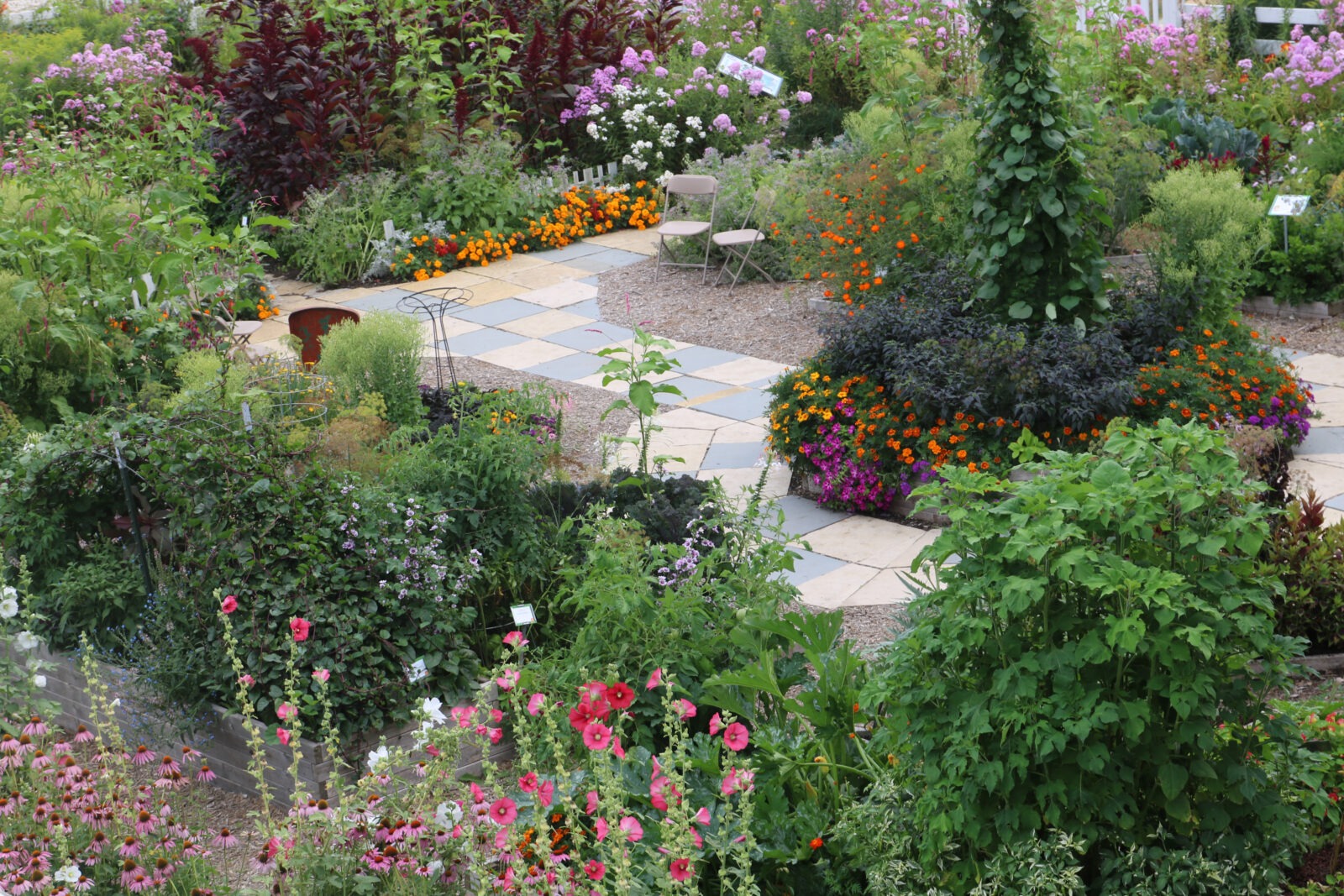
New Seed Varieties and Seed Collections – 2024
This article introduces and describes varieties and products introduced to the SSE catalog in 2024.
The 2024 Seed Savers Exchange catalog included 18 NEW seed varieties. From gorgeous flowers and hardy herbs to delicious and productive vegetables, there is truly something for everyone among these introductions. These varieties—along with more than 600 other open-pollinated, non-GMO varieties—are available online at shop.seedsavers.org.
And that’s not all. We also expanded our popular line of seed collections—six proven varieties curated around one theme—with two new collections: the Diane’s Garden Collection and the Pickling Collection.
Read on for details!
Shop all new and noteworthy seeds.
New Seed Collections
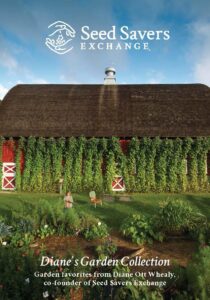
Each year, Diane Ott Whealy, SSE co-founder, plants and tends a show-stopping garden to the south of the historic barn at our Heritage Farm headquarters. This collection comprises six of Diane’s favorite varieties, grown year in and year out in her garden plot: ‘Grandma Einck’s’ dill, ‘Spider’ flower, ‘Hopi Red Dye’ amaranth, ‘Australian Yellowleaf’ lettuce, ‘Aurora’ pepper, and ‘Love-in-a-Mist’ flower.
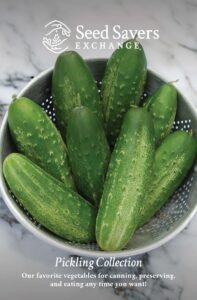
This collection comprises six varieties that taste great fresh and perhaps even better pickled: ‘Russian Pickling’ cucumber, ‘Bouquet’ dill, ‘Detroit Dark Red’ beet, ‘Burpee’s Stringless Green Pod’ bean, ‘Red Cored Chantenay’ carrot, and ‘Traveler Strain Jalapeño’ pepper.
Looking for a different themed collection? Shop all 11 seed collections.
New Seed Varieties
Heirloom Varieties From the Collection
Whether delicious to taste or stunning to view (or perhaps both), there’s a reason that the seven prized varieties introduced this December by Seed Savers Exchange (SSE) have stood the test of time. A truly unique eggplant guaranteed to wow in the field and on the plate, a gorgeous and tasty white pumpkin lovingly stewarded by one man for decades, a flavorful butterhead lettuce that likely originated in Germany more than three centuries ago, and a beautiful and hard-working marigold headline the organization’s new “From the Collection” offerings.
Preserved at SSE’s Heritage Farm headquarters, the ‘Sweet Red’ eggplant, the ‘Fortna White’ pumpkin, the ‘Crader Family’ lettuce, and the ‘Harvey’s Honor’ marigold are part of an impressive collection of more than 20,000 open-pollinated vegetable, herb, flower, and fruit varieties. Each year SSE regenerates and evaluates dozens of these varieties at its northeast Iowa headquarters, paying particular attention to high performers. The following seven varieties stood out in the field and on the table, and SSE is delighted to introduce them to market farmers, home gardeners, and seed savers everywhere.
‘Fortna White’ Pumpkin Squash
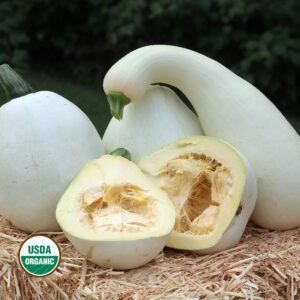
Lovers of unique heirloom pumpkins can thank the late Wayne Fortna of Gettysburg, Pennsylvania—a teacher who served as a tank commander under General George S. Patton during World War II—for the delicious, productive, and truly beautiful ‘Fortna White’ pumpkin.
Large, pear-shaped squash have pale-orange flesh with a memorable, mild, and slightly sweet flavor ideal for making pumpkin pies and many other sweet and savory dishes. Its productive plants bear pumpkins that weigh from five to eight pounds. This variety was grown by Wayne from the 1940s until his death in 1990; he tended it with particular care, ensuring there would always be a white pumpkin pie for his family at Thanksgiving. 90-100 days.
Try this ‘Fortna White’ pumpkin pie recipe!
‘Sweet Red’ Eggplant
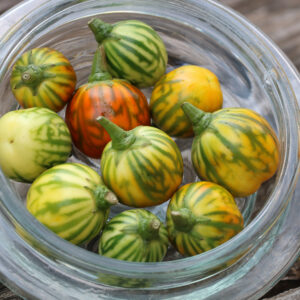
This Ethiopian eggplant variety produces small, round, flavorful fruit that taste moderately sweet and look stunning whether on the plate or in the garden. ‘Sweet Red’ eggplant can be eaten both raw and cooked, but is best enjoyed while still mostly green before ripening to an orangish red. SSE obtained this variety from Suzanne Ashworth, acclaimed author of Seed to Seed, who received it from Cue Vang, a sixth-grade Hmong student, in the late 1960s. Cue boiled the eggplant for about six minutes, mashed them in a mortar and pestle, and ate them as a dip. 45 days.
‘Crader Family’ Lettuce
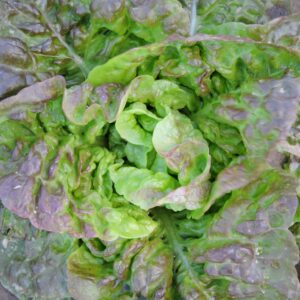
This butterhead variety has been savored for centuries. Flavorful, green leaves have a light-red blush, form a loose head, and taste not the least bit bitter, making them perfect for salads and wraps. SSE acquired this heirloom lettuce in 2014 from Mary Daniels of Missouri, who received the variety about 1957 from her parents, Daniel and Elizabeth Crader. Family lore suggests the family has grown it since Mary’s great-great-great-grandmother, Margaret Greter (surname later became “Crader”) brought seeds to the United States from Germany in 1719. 50 days.
Try this ‘Crader Family’ lettuce recipe!
‘Harvey’s Honor’ Marigold
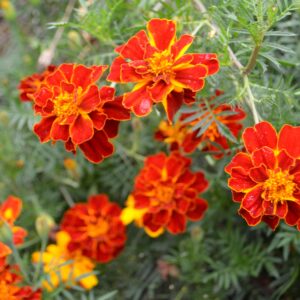
This gorgeous marigold flower bears prolific, velvety, scarlet-red blossoms with bright-yellow margins that bees and other pollinators absolutely adore. Its blossoms vary in color, with some much more yellow than red. Like other marigolds, this flower works well in companion plantings and enhances the growth of crops like cucumbers, eggplant, kale, squash, and tomatoes. SSE received this heirloom flower in 2011 from Robert Juhre of Washington; it has been grown in his family for at least three generations. 50 days.
‘Hosszu’ Parsley
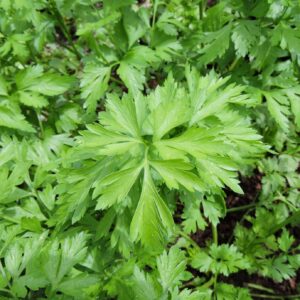
This flat-leaf parsley will perk up any dish with its distinctive taste and rich medium-green color. Leaves have a good flavor and a lasting aftertaste. SSE received this variety from Will Bonsall of Industry, Maine, who began sharing it in the Exchange seed-saving community in 1991. He indicated it originated in Hungary. 60-70 days.
‘Goose’ Lettuce
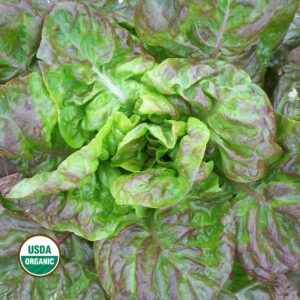
What’s not to like? This looseleaf lettuce variety matures early, has a deliciously sweet taste and excellent texture, and looks spectacular, with lush green leaves tinged with red. Listed for years on the Exchange (SSE’s gardener-to-gardener seed swap) by Arkansas resident John Small, this lettuce was a staple in the garden of John’s great uncle, Joseph Bremer, a country doctor who, as John recalls, tended an “unusually productive garden which always included ‘Goose’ lettuce.” 50-60 days.
‘German Butterbean’ Lima Bean
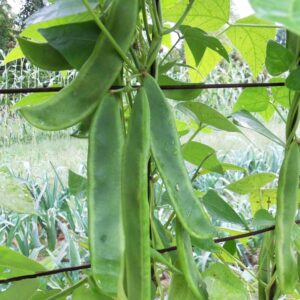
This vigorously climbing lima bean checks all the boxes. Its sweet, moist, and juicy beans have a distinctive, buttery taste and a smooth, creamy texture. SSE received this variety in 1994 from William Rastetter of Indiana, who in turn acquired it sometime before 1968 from a friend named Flossie (Canfield) Drake, also of Indiana. These lima beans were likely grown by Flossie’s mother, Margaret (Mendel) Canfield, in Dearborn County, Indiana, in the late 1800s. 60-79 days.
Additional New Varieties
Seed Savers Exchange is also your source for 11 other varieties for the first time in 2024, including a show-stopping and bright-colored calendula, three new varieties of carrot, and an ornamental, delicious, runner bean.
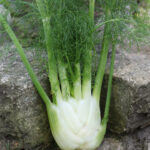
‘Finale’ Fennel (back for 2024)
Slow-to-bolt, succulent, crisp 4″ bulbs delight the taste buds whether eaten fresh, grilled, or roasted. Slightly flattened bulbs deliver a pleasant anise fragrance and flavor, while citrusy-tasting leaves accentuate salad dressings, sauces, and marinades. The ‘Finale’ fennel is bolt-resistant, and holds better in the field with a good shelf life after harvest. For optimal flavor, harvest the bulbs when they reach about 4″ in width before they produce a central seed stalk. 75 days.
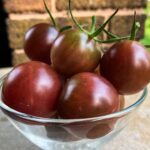
‘Chocolate Cherry’ Tomato
Always a treat, these plants produce delightfully flavorful cherry tomatoes continuously throughout the summer. Round fruits are borne on trusses of 6-8 and measure 1″ in diameter; fruits hold well on the stem and resist cracking but can be picked several days before reaching maturity without sacrificing quality. Dark purple in color, sweet and delicious in taste, this cherry tomato will dress up any salad. 70-75 days from transplant.
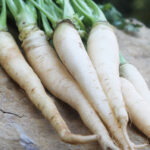
‘Lunar White’ Carrot
Popular in the Middle Ages, white carrots are enjoying a renaissance thanks to their distinctive creamy-white color, vigorous productivity, and mild, sweet flavor. The roots of this variety reach 8-12″ in length at maturity but can be harvested sooner for smaller carrots that are just as flavorful whether eaten fresh, steamed, or roasted. Plants are half-hardy to frost and light freezes; cooking brings out their sweet flavor. This variety will be loved to the moon and back! 75 days.
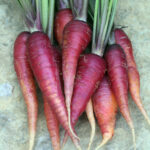
‘Cosmic Purple’ Carrot
There’s a reason purple carrots have been around for at least a millennium! Purple on the outside with a sweet, orange core, this stunning carrot peaks in taste and texture when its tapered roots reach 7″ in length and never disappoints on the dinner plate. Kids love the color and taste; adults love the taste and the fact that purple carrots contain not only vitamin A but also the antioxidant anthocyanin. Gardeners can’t go wrong with this galactically glorious carrot! 75 days.
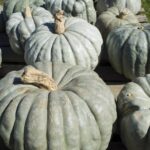
‘Jarrahdale’ Pumpkin Squash
Cook it. Carve it. Keep it. Could this be the perfect squash? Its stunning, silvery bluish-gray color and ribbed appearance stand out in the garden and in ornamental displays. Known for its sweet taste, ‘Jarrahdale” also makes a statement in pies, soups, and stews. Squashes weigh 10-12 pounds and keep for more than 12 months, ensuring a year-round supply that can be carved, baked, or cooked like any other stringless variety. 90-100 days.
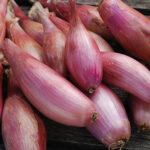
‘Zebrune’ Shallot
This delicious echalion (or banana) shallot originated in France, where it is called Cuisse de Poulet du Poitou or “leg of the chicken.” Plump, pinkish-brown bulbs taste sweet and mild, making this culinary superstar an excellent choice for both everyday and gourmet cooking. This long-day variety produces large yields in the first year (if planted early) and keeps extraordinarily well, ensuring a good supply over many seasons. 100 days.
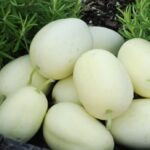
‘Dragon’s Egg’ Cucumber
These aptly named, cream-colored cucumbers resemble large eggs. Thin-skinned fruits are mild, faintly sweet, and not the last bit bitter, making them perfect to snack on straight from the vine or toss into a salad of fresh greens. Plants bear fruit early in the season and produce heavy yields. This decidedly delicious, easy-to-grow heirloom originated in Croatia and has delighted gardeners for generations. 55-65 days.
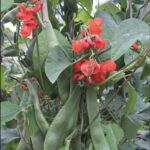
‘Black Coat’ Runner Bean
Edible? Check! Ornamental? Check! Heirloom? Check! This unique runner bean produces sturdy 6-7’ vines that bear both vivid scarlet blooms and flavorful beans that are edible at the immature pod stage (like a green bean) and at the mature stage (like a kidney bean). Pretty, plump bean seeds change first from pink to purple, and finally to a glossy, ebony black. Dating back to the mid-1600s, this variety was first recorded by German botanist Michael Titius in his Catalogues Plantarum. 75 days.
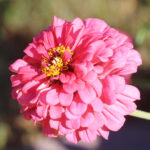
‘Luminosa’ Zinnia
Large and lovely, this truly delightful zinnia makes a bold statement in any garden, border, or container with its massive pink petals. Perhaps even better? Its bountiful blossoms last for days and attract bees, butterflies, and other pollinators throughout the summer months. Easy to grow and easy to love, this zinnia also makes a memorable addition to cut-flower bouquets. Annual. 70 days.
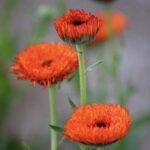
‘Neon’ Calendula
The ‘Neon’ Calendula is a real show-stopper! This flower’s brilliant, red-orange blossoms command attention no matter where they’re grown. Easy-to-grow plants typically reach 18-24″ tall and produce abundant (and edible!) blooms from late spring to autumn. Like other calendula varieties, this hardworking flower works well in companion plantings as it attracts beneficial insects and pollinators even as it repels unwanted pests, including tomato worms and nematodes. Annual. 60 days.
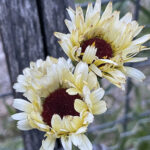
‘Ivory Princess’ Calendula
This calendula’s elegant look and refined color complement any selection of flowers, herbs, and vegetables. Easy-to-grow plants typically reach 18-24″ tall and produce abundant, edible blooms of cream-colored petals that surround a dark-red center base. Flowers bloom from late spring to autumn; their tangy-tasting petals can be used fresh or dried in soups, baked goods, and salads. Like other calendula varieties, ‘Ivory Princess’ attracts beneficial insects and pollinators and repels unwanted pests. Annual. 60 days.
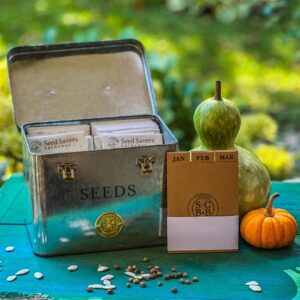
Seed Storage Tin
Anyone who saves seeds knows the struggle of finding seed storage! We have just the thing. This galvanized seed storage tin is very practical—and attractive—containing three compartments for seeds that hold even large seed packets. The calendar dividers help sort seeds by month. Makes a great gift for any gardener!